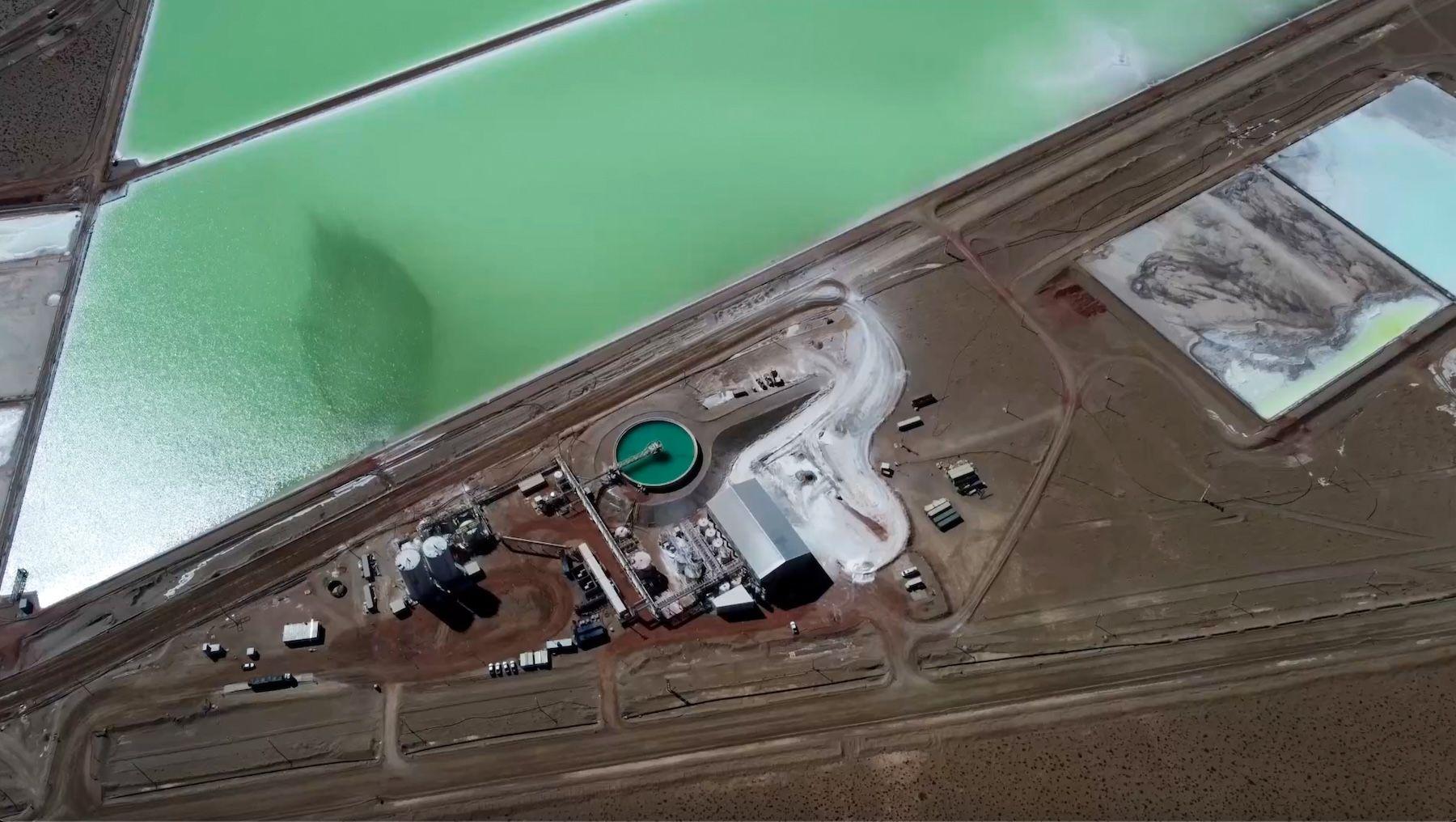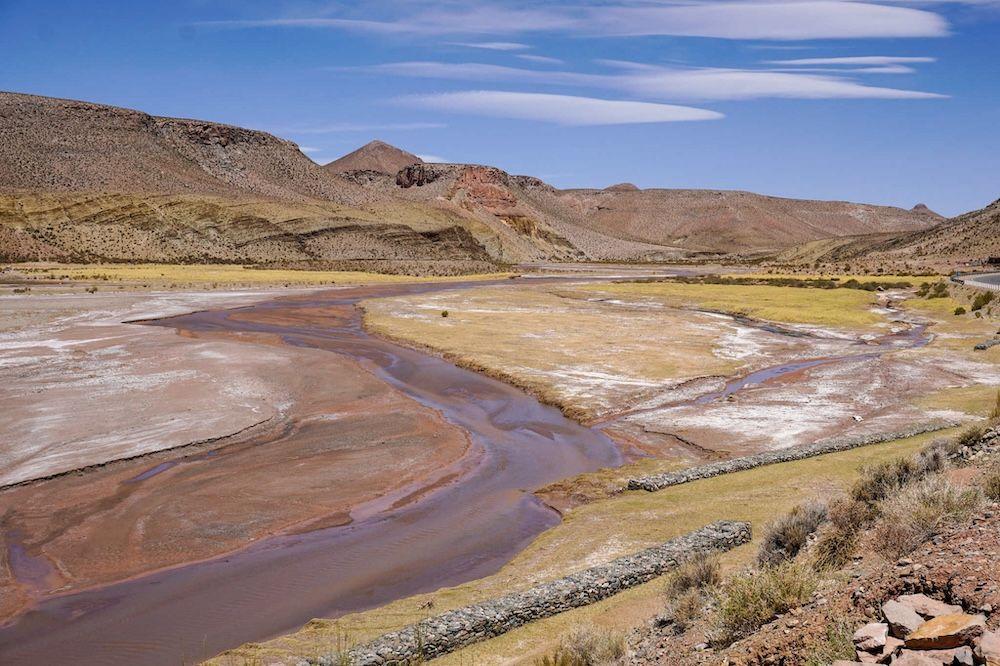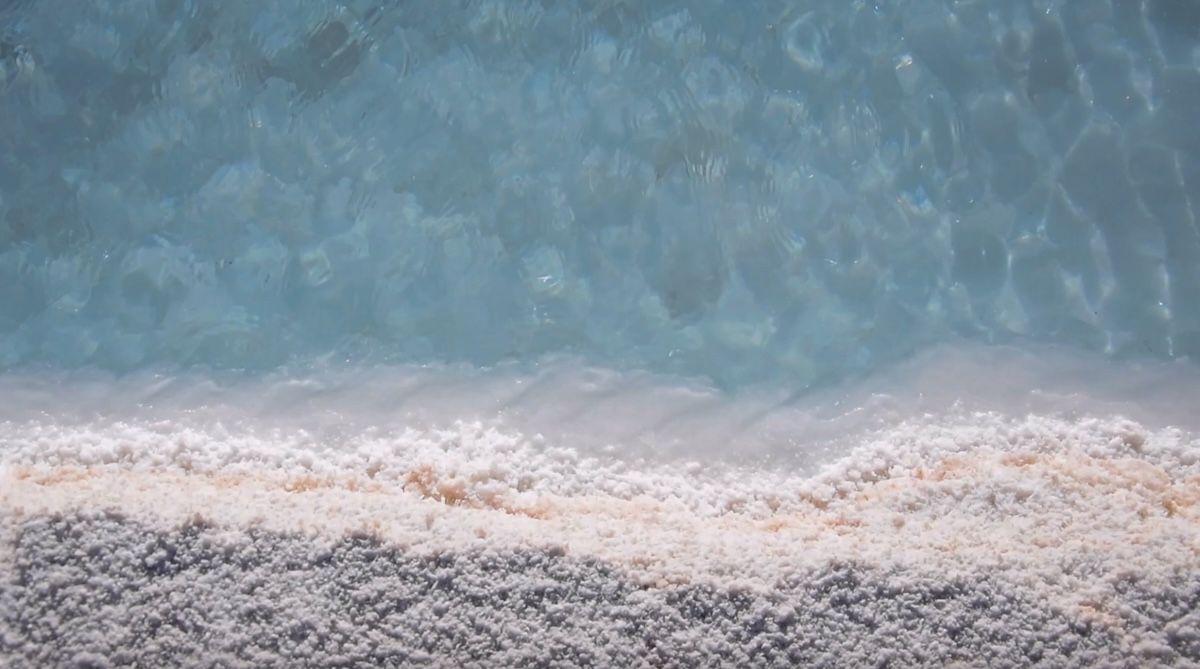View of the town of Santuario de Tres Pozos and a salt pool in Salinas Grandes, province of Jujuy, in northern Argentina.
This story was originally published by Global Press Journal.
By Lucila Pellettieri, Senior Reporter
Jujuy, Argentina
Sun and dust plague this landscape of rocks and cracked soils. At more than 12,000 feet above sea level (3,700 meters above sea level) in the Andes, thirsty shrubs and animals pile up on the edge of what was once a mighty river and through which now barely a trickle of water passes.
Local people have been watching rivers, wells and veins dry up for years. Meanwhile, surreal pools of turquoise water dot the landscape like a mirage.
More than a decade ago, indigenous communities in the Puna region (the highest plateau after Tibet) accepted that two lithium mining companies, Minera Exar and Sales de Jujuy, would operate in the department of Susques. They expected that the mines would bring jobs and development, along with the careful environmental management that was promised to them. Some local people work for the mines, but the demand for lithium batteries has left them without enough water to live comfortably, or even to support their livestock and crops. While lithium helps power electric cars, computers and other high-end technology, it jeopardizes basic survival in one of the driest spots in Argentina.
Desperation has led some people to drink water from the Pastos Chicos River, which contains arsenic from volcanic activity. Arsenic levels in the river reach 1,400 parts per million and considerably exceed the threshold that, according to the World Health Organization, can cause cancer.
Global Press Journal tried to contact Minera Exar y Sales de Jujuy through emails, social media requests, physical letters and more than 20 phone calls, but received no response. Meanwhile, the government of the province of Jujuy denies that mining operations dry up water reserves.
“It is totally false to say that the exploration and/or production of lithium carbonate consumes the water available to communities, since water for [local] consumption comes from other sources, which are not affected by the projects,” says an August 2023 report from the Jujuy government. However, independent studies show that mines are indeed to blame for the depletion of water in the area.
Evaporation ponds in the lithium mine, Sales de Jujuy S.A. Photo: Lucila Pellettieri, Global Press Argentina.
Walter Díaz Paz, environmental engineer at CONICET, Argentina's National Council for Scientific and Technical Research, who has written numerous reports on lithium mining in the Puna, says mining companies obscure the facts.
The extraction of water by mining companies is “completely linked” to the fact that several people's water wells have dried up, Díaz Paz says.
Lithium mining is projected to grow exponentially in Argentina. The country has the third largest lithium reserves in the world and is the fourth global producer, although President Javier Milei believes that mining is “significantly underdeveloped”. April made it cheaper and faster for companies to import mining equipment and materials.
In June, President Milei secured congressional approval of another law that gives mining companies significant benefits such as tax cuts and 0% tariffs on imports for 30 years, among other incentives. He has met twice with Elon Musk, the co-founder and CEO of Tesla, a giant in batteries and electric cars, which is also one of the largest consumers of lithium in the world.
This economic plan worries people in the Susques department. The mines employ approximately 30% of the department's workers, but this is of little importance if the water is disappearing.
Reinaldo Luzco fills two tanks with river water. The well he relied on as a source of drinking water dried up three years ago, and now he is sometimes forced to drink river water that naturally contains arsenic. Photo: Lucila Pellettieri, Global Press Argentina.
Three years ago, Reinaldo Luzco, 75, was drawing water from a natural well near his house for his family and his goats. Today that well is dry. Now he depends on others to bring him water from the town and when it's not enough, he drinks river water that naturally contains arsenic.
“What are we going to do? Without reserves [of water] we are going to die,” Luzco says.

Evaporation ponds in the lithium mine, Sales de Jujuy S.A. Photo: Lucila Pellettieri, Global Press Argentina.
The 'white gold of the 21st century'
For thousands of years, rainwater has been flowing down from these peaks in the Andes, slowly eroding salts and lithium from the rocks to form a brine that penetrates the lakes, salt flats and aquifers of the Puna.
It is estimated that Argentina has 20 million tons of lithium in this brine; that is, 10% of the world's known lithium reserves. Extracting it requires drilling the salt flats (the white, cracked surfaces of what were once lakes and have now completely evaporated), and pumping the underground brine to nearby evaporation pools. Once it reaches these artificial ponds, the brine is allowed to evaporate for up to two years. It is then processed and lithium carbonate is obtained, a white salt that once refined is used in the production of batteries.
During 2023, Minera Exar and Sales de Jujuy extracted about 12.2 billion liters of brine, according to the production levels declared in their environmental impact reports, and the consumption of brine per ton calculated by experts from the National Council for Scientific and Technical Research of Argentina.
During the same period, both companies extracted more than 3.7 billion liters of “industrial water” - technically, fresh water - to produce what is widely known as the “white gold of the 21st century”. This amount is equivalent to more than 31 times the annual water consumption of the inhabitants of the Susques department. Just two years earlier, lithium mines had used five times the freshwater consumption of the residents of the department. In 2023, after Sales de Jujuy expanded its operations and Minera Exar began producing, freshwater extraction soared 535%. And companies have plans to expand even more.
Now, four mines produce lithium in Argentina: the Sales de Jujuy and Minera Exar mines, which are located in the province of Jujuy, the Fénix mine in the province of Catamarca and the Centenario Ratones mine, in the province of Salta. Two other mines are expected to start operations this year; more will follow. According to a November 2023 report from the Argentine Mining Secretariat, another 40 lithium mining projects are under development.
The crucial thing for people who live in the Puna is that this massive extraction of water under the salt flats affects the distribution of groundwater reservoirs in the region, which are classified as fresh, brackish, salt or brine. All of them are connected through mixing zones.

The above is not surprising. A study conducted in 2018 by Argentina's Environment and Natural Resources Foundation (FARN) modeled the predicted impacts of lithium mining in the Olaroz-Caucharí hydrological basin in the Puna. According to the research, the massive pumping of brine in the Susques department - which began in 2015 - is likely to draw nearby fresh water to the salt flats, where it will become irreversibly salty. The study also found that the levels of the Olaroz-Caucharí basin are almost certain to decrease, causing springs, lakes, lagoons and wells to dry up.
And that's exactly what the locals are seeing.
Less water available
María Norma Vasquez's courtyard houses an army of buckets, drums and basins. This is his last defense against frequent interruptions in his town's water service, a network of hoses that draw water from a nearby spring. Drinking water is supplied from a tank in the town's main square, fed by a nearby low-flow spring.
“Sometimes we don't have enough to clean, to wash our clothes, to do hygiene, or anything,” he says.
The Vegas where the animals drank from are dry, says Eva, who asked that her last name not be mentioned for fear of reprisals.
“I feel like they suck all the veins out of all the hills,” Eva says.
María Norma Vasquez poses for a portrait next to the water containers in her yard. Photo: Lucila Pellettieri, Global Press Argentina.
Mining companies have made some effort to alleviate competition for water. In 2022, Minera Exar spent nearly 87 million Argentine pesos (about 500,000 dollars at the time) to bring bottled water to its employees in order to avoid the consumption of local drinking water. That same year, the company also spent 640,000 pesos (about 3,400 dollars at the time) to supply water to 104 houses in the rural region of Salar de Olaroz, according to the company's 2022 sustainability report.
These efforts have not allayed concerns. Many people no longer want mining companies to be there. They are joining the voices that began to be heard in 2012 in the Salinas Grandes-Guayatayoc basin, neighboring the Salar de Olaroz basin. There, 33 native communities created in 2015 a document called the Kachi Yupi, which requires companies that want to establish themselves in the area to follow a consultation protocol that respects the culture of indigenous groups.
But that protocol finally came to nothing after the Jujuy provincial government failed to endorse it.

Last year, indigenous communities received another severe blow.
In June 2023, the Jujuy government approved an express constitutional reform. The process was carried out in just over 30 days without a public consultation. The reform establishes that fiscal land, such as those inhabited by these communities, may be expropriated and used for productive developments such as lithium mining. It also prohibits protests and demonstrations involving road blocks, one of the few methods that demonstrators had to make themselves heard.
There are some small signs of change. In March, in the province of Catamarca, after people reported the negative effects of lithium mining in the Los Patos River, a court banned all new mining permits in the area and ordered the provincial government to carry out a new environmental impact study.
Even so, the will of some communities is shattered. This year, Lipán, one of the 33 communities that signed the Kachi Yupi, separated from the others and allowed exploration to begin for the extraction of lithium on their land.
Members of the original peoples of Jujuy and their supporters held protests and marches against the constitutional reform of the province in Buenos Aires. Photo: Lucila Pellettieri, Global Press Argentina.
Opportunities and resentment are growing
Aerial view of the pools of the lithium mining company Sales de Jujuy S.A. Photo: Lucila Pellettieri, Global Press Argentina.
Government reports and mining companies “intentionally ignore” the effect of mining activities on underground reservoirs, says Díaz Paz, the environmental engineer who has studied the impact of lithium mining in the region. They say that only one area is being exploited, but that exploitation leads to a decrease in surface flows and in the volume of water that reaches Las Vegas, he explains.
Another problem, Díaz Paz says, is that mining companies use the term “industrial water” — coined by the industry itself and which is not used in any scientific classification — to refer to fresh water that does not meet the standards to be considered drinkable.
Mining companies classify this untreated fresh water — which local people use for their animals and crops — as “industrial water”. Therefore, they can extract it while denying that they are competing with the community.
José Gómez, Secretary of Mining and Hydrocarbons of the province of Jujuy, says that there are more than 70 monitoring points around the basin to ensure that mining does not salinate fresh water.
And it recognizes that industrial water is what people drink and use for their fields.
“The water is the same, yes, of course,” he says.
Before the arrival of mining companies, people used both fresh and brackish water from local sources for drinking and for their animals.
Today, many of Las Vegas are dry or have been covered by evaporation pools. But the mines have created opportunities for employment, investment and cell phone service, says a Susques resident, who prefers not to disclose his name to preserve his work as a supplier to mining companies.

View of the Pastos Chicos River that residents sometimes have to use as a source of drinking water, even though it naturally contains arsenic. Photo: Lucila Pellettieri, Global Press Argentina.
Like other people in the area, he says that local communities accepted mining companies out of necessity, in the hope that they would generate employment and development in an area with a subsistence economy.
“The communities wanted to make a contribution to the country, they wanted to generate work, to connect to the world,” he explains. “We may have done it wrong, we don't know.”
The answer to that question is simple, says Pablo Bergese, coordinator of mining sustainability for the Ministry of Mining and Hydrocarbons of Jujuy. Other efforts to alleviate poverty in the area have failed, he says. The only way to develop the area is to take advantage of mining wealth, he adds.
“People have developed in terms of homes. They have better accessories. They have better bathrooms. They have better buildings. They have community centers,” Bergese says. “Unfortunately, development has an impact on the environment. That's what we deny out there. The human being impacts the environment in all their activities. Mining is just another one, let's say.”
However, many local people feel left behind.
José Sajama, leader of the Abra Pampa community, north of the Salar de Olaroz, is the son and grandson of miners, but he has a very different vision of mining here in the Puna.
“Minerals have been developed in much of the Puna, and why are people still poor? What is the development? Or is it development for whom?” , asks Sajama.
María Arce, GPJ, contributed to this article.
Global Press Journal is an award-winning international news publication with more than 40 independent news offices in Africa, Asia and Latin America.









Comentarios (0)